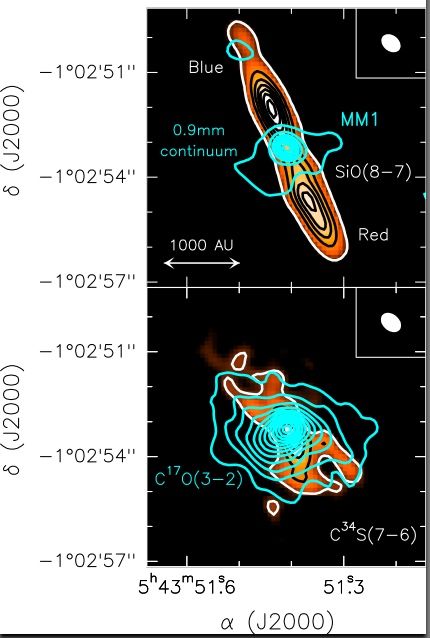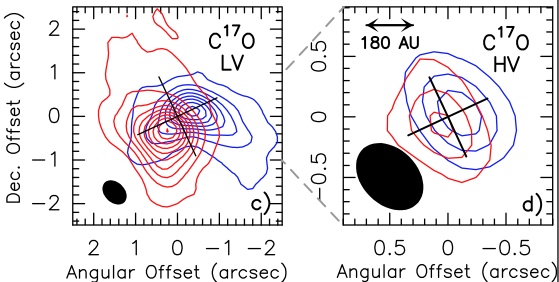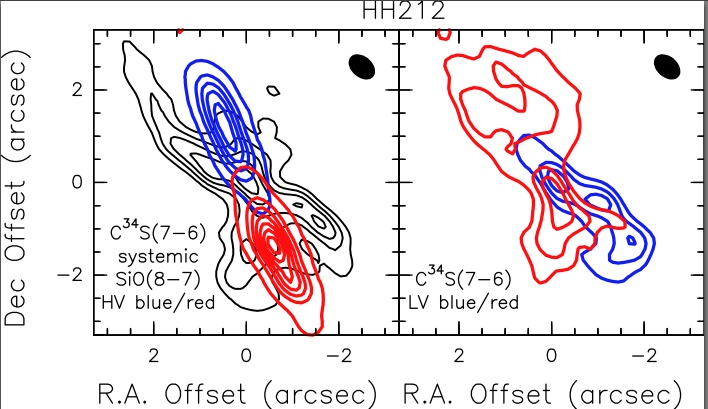A picture of a Sun-like protostar: the jet, the cavity and the forming disk
The formation of a Sun-like star is strongly influenced by jets and outflows in the early protostellar phase (called Class 0). However, the launching process of jets from young accreting low-mass (Sun-like) stars remains one of the most enigmatic phenomena in astrophysics. It is currently believed that jets are launched via a magneto-hydrodynamical (MHD) process in which the magnetic field removes excess angular momentum, thus allowing accretion of gas and dust onto the central object. However, the precise launch region (star, inner disk edge at 0.1 AU, outer disk at 0.1-10 AU) remains unknown. In the latter case, the implied disk magnetic field would strongly affect planet formation and migration. MHD-driven jets and swept-up outflows are also believed to play a crucial role in the star and disk formation process itself.
MHD simulations of protostellar collapse with typical amounts of rotation and magnetization show that MHD outflows are an unavoidable outcome. However, the same simulations show that magnetic braking by the outflows and twisted B-fields is so efficient that keplerian disks may be initially suppressed beyond 10 AU. This is the so-called magnetic braking catastrophe. On the other hand, much larger keplerian disks of 100-150 AU have been reported in already two Class 0 sources (L1527, VLA1623), raising the acute question of their formation. Detailed observations and characterization of a larger number of pristine infall-outflow systems are thus essential to clarify the role of jets and outflows in removing angular momentum and mass from the system to elucidate the enigmatic disk formation process.
The protostellar system HH212 is an ideal laboratory to investigate the interplay of infall, outflow and rotation in the earliest stages of the low-mass star forming process. HH212 is a strikingly bright and symmetric bipolar jet from a Class 0 source in Orion (at 450 pc) first revealed in H2 imaging. Its innermost regions have been extensively studied in CO and SiO at scales down to ≃ 0.3′′-0.4′′. These maps revealed a bright bipolar SiO microjet with inner peaks at ±1–2′′ = 450–900 AU of the protostar, invisible in H2 due to high extinction. The molecular SiO jet width ≃ 100 AU is remarkably close to atomic jet widths in evolved T Tauri stars, favouring a universal MHD collimation process. Interestingly, a flattened rotating envelope in the equator perpendicular to the jet axis was observed in NH3 with a radius of ∼ 7000 AU. The dust continuum imaged by ALMA is flattened perpendicular to the jet and suggestive of a disk of (maximum) radius ≃ 0.3 AU.
A group of researchers led by Claudio Codella (researcher at the Observatory of Arcetri) and including Linda Podio (AstroFIt fellow at the Observatory of Arcetri) and collaborators from France, Spain and Germany have recently presented ALMA observations of HH212. Figure 1 compares the emission maps in 850 µm continuum, SiO(8–7), C17O(3–2), and C34S(7–6). The combination of these tracers allowed them to simultaneously image in a single ALMA spectral set-up different ingredients of the star formation process: (i) a pair of narrow SiO jets launched from the protostar (dust peak) (ii) an extended flattened C17O envelope around the outflow waist, and (iii) biconical C34S emission lobes surrounding the jet.
 |
Fig. 1. The HH212 protostellar system as observed by ALMA Cycle 0 in Band 7: the protostar, the jet, the envelope, and the cavity. Upper: 850 µm continuum (turquoise contours) on top of SiO(8–7) integrated between -23 and +15 km s−1 (colour scale and black contours), with respect the systemic velocity Vsys. Bottom: Contour plot of the C17O(3–2) emission (turquoise) on top of the C34S(7–6) emission (colour and black), both integrated in the Vsys ±6 km s−1 range. From Codella et al. (2014) |
Figure 2 shows that the low-velocity C17O emission (left) is mainly tracing the walls of the southern cavity carved by the outflow into the envelope. The walls are rotating in the same sense as the protostellar envelope, i.e. with blueshifted gas in the west and redshifted gas in the east, as expected for material swept-up and compressed by the outflow. However, at higher velocities ≃ 1.9–3.5 km s−1 from systemic (right): (i) the E-W velocity gradient is still present, and (ii) the emission is definitely more compact (≤ 0.5 arcsec). All these findings support the existence of a rotating disk of radius 90 AU around a protostar with 0.2 solar masses, possibly in keplerian rotation inside this radius.
Near systemic velocity, C34S is imaging a biconical structure surrounding the SiO jet and with the protostar at the vertex (see Fig. 3-Left). A surprising finding is the S-shaped warp seen in C34S, despite the very straight axial jet. Similar cavity asymmetries are predicted by MHD simulations during protostellar collapse with misaligned magnetic field and angular momentum vectors; hence the C34S warp might be a remnant imprint of this initial configuration. Figure 3-Right further indicates that the C34S southern lobe is clearly rotating about the jet in the same sense as the C17O cavity. This suggests that the C34S emission may be filling-in the swept-up cavity walls delineated by C17O, and trace a rotating wide-angle flow with a nested onion-like velocity structure, highly reminiscent of that seen in the atomic jet from the T Tauri star DG Tau. It would be the first time that such a structure is observed in a Class 0 source.
 |
 |
|
Fig. 2. Left: Blue- and redshifted C17O(3–2) emission in the low-velocity (LV) range (±0.6–1.5 km s−1 from Vsys), tracing the rotating outflow cavity. Right: same as in the Left panel for the high velocity (HV) velocity range (±1.9–3.5 km s−1 from systemic), tracing the rotating inner disk. From Codella et al. (2014). |
Fig. 3. Left: SiO(8–7) channel maps at Vsys ±8 km s−1 (blue and red) overlaid on top of C34S(7–6) close to systemic velocity (black). Right: C34S(7–6) channel maps at low blue and redshifted velocities ∼ Vsys ±0.9 km s−1, showing a rotating wide-angle flow about the jet axis. From Codella et al. (2014). |
The results of this study are presented in the Astronomy and Astrophysics Letter “The ALMA view of the protostellar system HH212: the wind, the jet, the cavity” by Codella et al. 2014 (A&A 568, L5).
The research team devoted to these studies includes: Claudio Codella (researcher at the Observatory of Arcetri), Linda Podio (AstroFIt fellow at the Observatory of Arcetri), Gina Santangelo (INAF-OAArcetri and Rome), S. Cabrit (LERMS, France), F. Gueth (IRAM, France), R. Bachiller (IGN, Madrid), A. Gusdorf (IGN, Madrid), B. Lefloch (IPAG, France), S. Leurini (MPIfR, Bonn), B. Nisini (INAF-Rome), M. Tafalla (IGN, Madrid), W. Yvart (LERMA, France).
Edited by Claudio Codella and Anna Gallazzi, 22/9/2014



